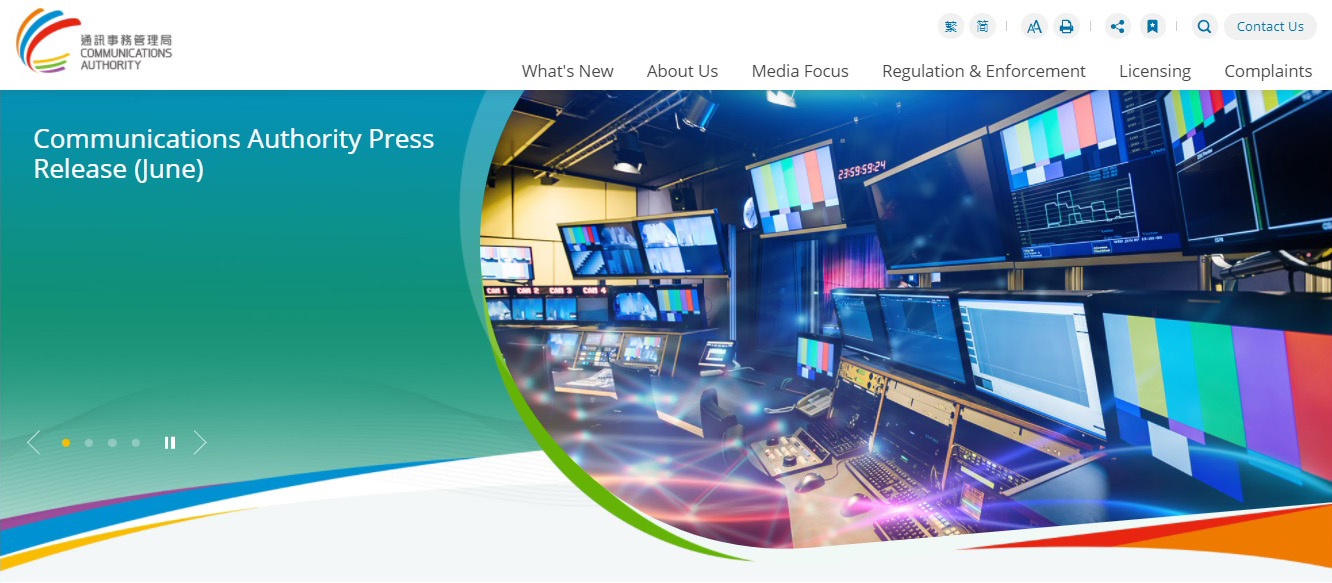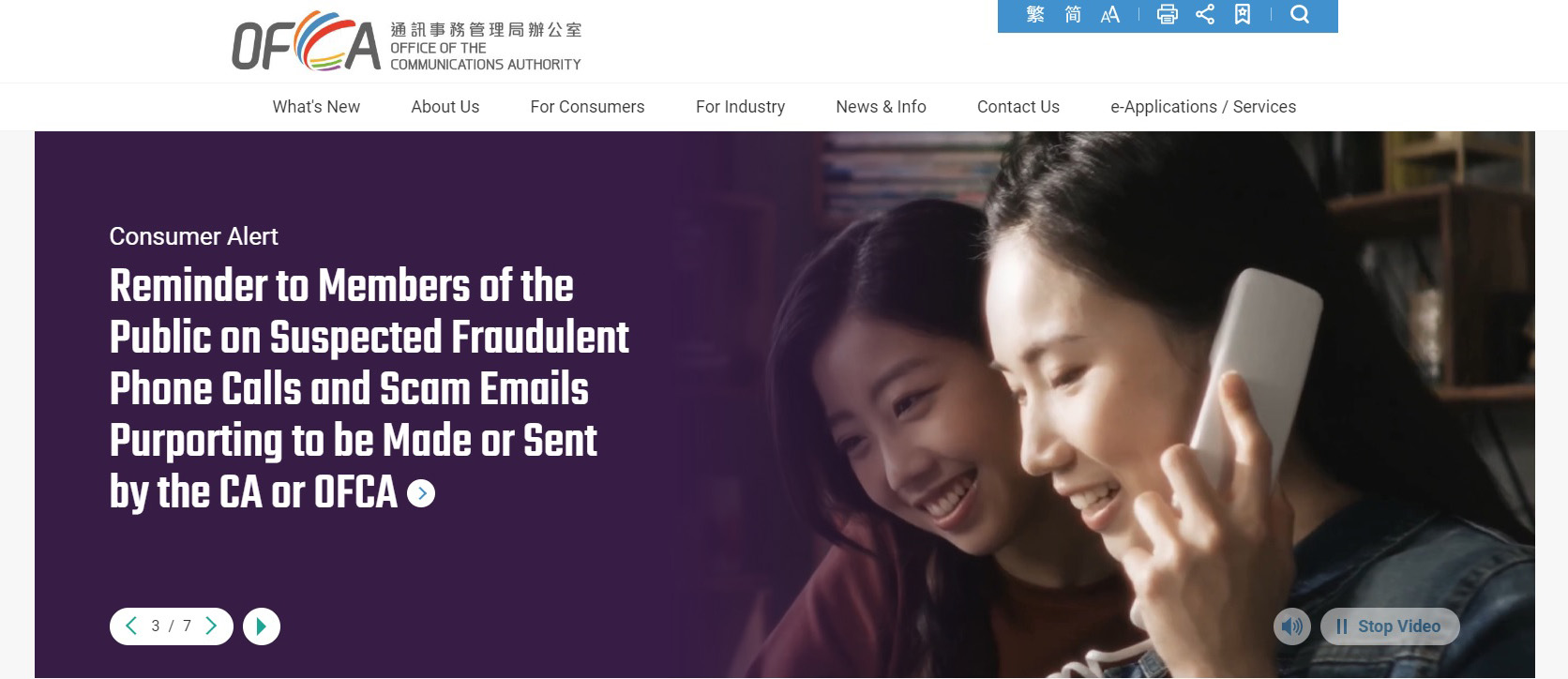

The Competition Ordinance (CO) provides for a cross-sectoral competition law prohibiting anti-competitive conduct in all sectors. Under the CO, the CA is conferred concurrent jurisdiction with the Competition Commission to enforce the CO in respect of the conduct of undertakings operating in the telecommunications and broadcasting sectors, including merger and acquisition activities involving carrier licensees in the telecommunications sector.
Pursuant to the memorandum of understanding signed by the CA and the Competition Commission, the CA will ordinarily assume the role of the lead authority for matters falling within the concurrent jurisdiction. For matters involving issues that are partly within and partly outside the concurrent jurisdiction, the CA and the Competition Commission will discuss and agree on how best to process the matter on a case-by-case basis.
From 1 April 2020 to 31 March 2021, a total of 39 complaints and enquiries were received under the CO, with 38 cases closed without the need for further action and one case under processing.
The fair trading sections of the Trade Descriptions Ordinance (TDO) prohibit certain specified unfair trade practices by traders in the provision of goods and services to consumers.
The CA is conferred concurrent jurisdiction with the Customs and Excise Department to enforce the fair trading sections of the TDO regarding the commercial practices of licensees under the TO and the Broadcasting Ordinance directly connected with the provision of telecommunications and broadcasting services. The two enforcement agencies have entered into a memorandum of understanding to coordinate the performance of their functions under the fair trading sections of the TDO and have issued a set of enforcement guidelines to provide guidance for traders and consumers regarding the operation of the fair trading sections.
From 1 April 2020 to 31 March 2021, OFCA handled a total of 264 complaints under the TDO, of which 207 were closed due to insufficient evidence to establish a contravention or because they fell outside the scope of the TDO; three were closed after the CA issued advisory letters to the licensees concerned to bring the subject matter to their attention and advise them of the need to improve their relevant commercial practices in relation to the sale, supply or promotion of telecommunications or broadcasting services to consumers; and the remaining 54 were under processing.

The CA has established three Do-Not-Call (DNC) Registers, for facsimile messages, short messages and pre-recorded telephone messages respectively, under the Unsolicited Electronic Messages Ordinance (UEMO). Commercial electronic messages (CEMs) must not be sent to registered telephone numbers unless the senders have obtained consent from the registered users. As of March 2021, more than 2.6 million telephone numbers were registered with these three DNC Registers. Apart from not sending CEMs to the registered telephone numbers on the DNC Registers, senders of CEMs are also required under the UEMO to comply with a number of rules. For example, they must provide the recipients with their contact information and an “unsubscribe facility” in their CEMs so that the recipients can approach the senders and unsubscribe from receiving their CEMs.
In 2020/21, OFCA received 565 reports regarding suspected contraventions of the UEMO, a reduction of about 6% from the previous year. A majority of these reports were related to short messages, pre-recorded telephone messages and email messages. OFCA will continue to monitor the compliance situation on various messages and platforms and streamline the procedures for more effective enforcement.
If the number of reports received against a sender is below a certain threshold, OFCA will issue an advisory letter reminding the sender to observe the requirements under the UEMO. If the number of reports received against a sender exceeds the threshold, or if OFCA continues to receive reports against the same sender after the issuance of an advisory letter, OFCA will conduct a formal investigation and may issue a warning letter to that sender. In 2020/21, a total of 80 advisory letters and 16 warning letters were issued.
In the event of repeated contraventions by the senders of CEMs, the CA may issue enforcement notices in accordance with section 38 of the UEMO directing the senders to take steps to remedy the contraventions. Anyone who fails to comply with an enforcement notice may be liable to a fine of up to HK$100,000 on the first conviction.

In order to safeguard consumer interests in the use of telecommunications services, OFCA takes proactive actions to implement various consumer protection measures and works with the industry to draw up and implement self-regulatory measures for addressing new consumer issues that may arise from time to time.
These measures include the voluntary Customer Complaint Settlement Scheme (CCSS) administered by the Communications Association of Hong Kong, an industry association. The CCSS aims to help resolve billing disputes in deadlocks between telecommunications service providers and their customers through mediation.
Other self-regulatory measures voluntarily implemented by the industry include the promulgation of the Code of Practice for Telecommunications Service Contracts to improve the clarity of provisions in the telecommunications service contracts, as well as the Code for the Provision of Chargeable Mobile Content Services to govern the practices of third-party content service providers.
Some other examples include the implementation of mobile bill shock preventive measures as well as publication on OFCA’s website details of the arrangements adopted by major residential broadband service providers to handle service termination requests from consumers.
OFCA will continue to monitor the implementation and effectiveness of the various consumer protection measures adopted and where necessary engage the industry to seek further improvement of the existing measures or introduce new measures.
With the rapid development of technologies, telecommunications services have become indispensable for people from all walks of life and ages. However, some telecommunications service users who are disadvantaged due to various circumstances (such as age, disability, low literacy or communications difficulties) may not be able to get the appropriate assistance and hence may make purchasing decisions that do not best suit their needs. In this regard, OFCA created a dedicated webpage to provide consumer advice to disadvantaged telecommunications service users in April 2021 including relevant tips for subscription to and use of telecommunications services under different scenarios.

A dedicated webpage which provides consumer advice to disadvantaged telecommunications service users
Since December 2010, OFCA has been providing a broadband performance test system enabling broadband service users to measure the performance of their broadband connections, including download and upload speeds, network latency, packet loss and jitter. Apart from users of desktop and notebook computers, users of smart phones and tablets running iOS and Android operating systems may also make use of the test system.
From time to time, OFCA reviews and upgrades the test system to enhance its capability and performance. Currently, it supports speed tests of up to 10 Gbps for desktop and notebook computers and up to 1 200 Mbps for iOS-based and Android-based mobile devices. From service launch until March 2021, more than 105 million broadband performance tests were conducted via the system.
OFCA continued to arrange publicity activities and disseminate consumer messages through different media channels during the year. Apart from the well-established Facebook fan page “Communications Master · OFCA”, a new social media channel on Instagram was launched in February 2021 primarily for the younger generation. Various consumer information and tips are conveyed to the public through these two social media platforms to educate the public on smart use of communications services.

To raise public awareness of the migration of six digital television programme channels to new transmitting frequencies, a one-year publicity campaign was launched on 1 December 2020. Intended for the general public, the campaign consisted of a wide array of publicity programmes, such as the issue of press releases and consumer alerts, placement of advertisements on OFCA’s social media platforms and in free newspapers, productions of two sets of television and radio announcements and a short video, as well as the distribution of posters and flyers to the public through various channels.
During the year, OFCA also helped to increase the public’s awareness of the EAS by issuing press releases, producing television and radio announcements, distributing posters and placing advertisements on different online and social media platforms.
The fully redesigned and upgraded version of the websites of the CA and OFCA were launched in March 2021. Apart from having brand new designs to enhance the corporate images of the CA and OFCA, the websites also adopt a mobile-friendly design that enables the general public to have better browsing experience on different mobile devices.



OFCA launched a series of TV announcements and videos to promote different consumer messages, including migration of six digital TV programme channels to new transmitting frequencies, how to rescan digital TV programme channels, and emergency alert system.


New websites of CA and OFCA were launched in March 2021.